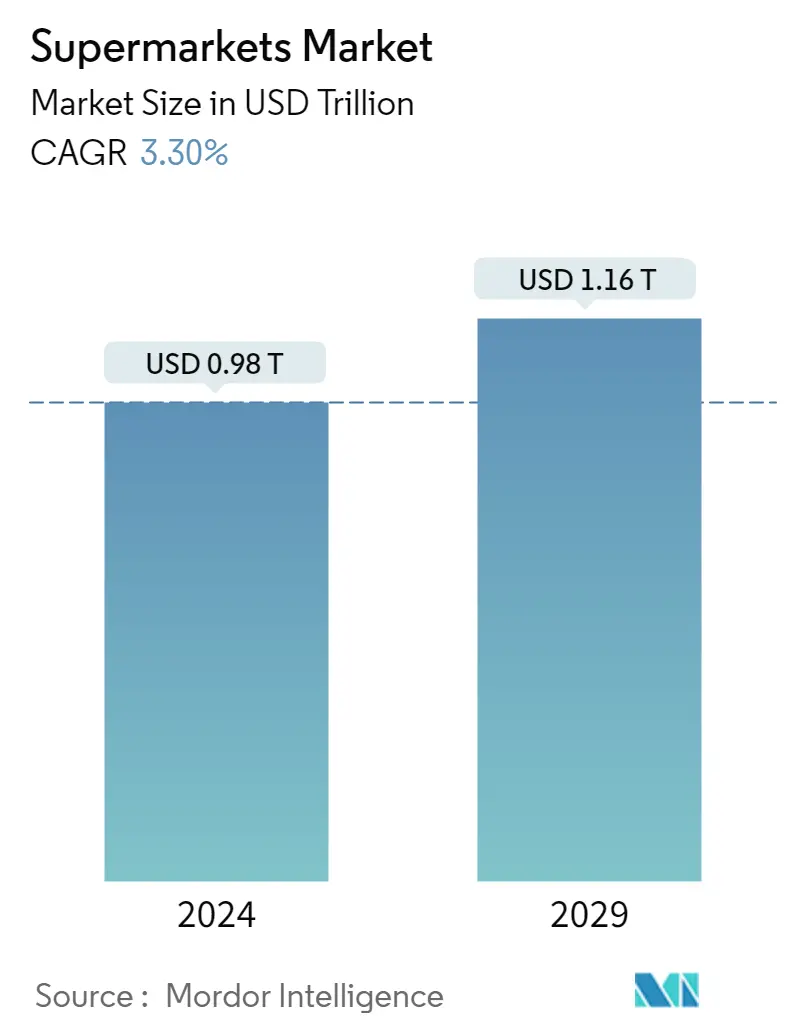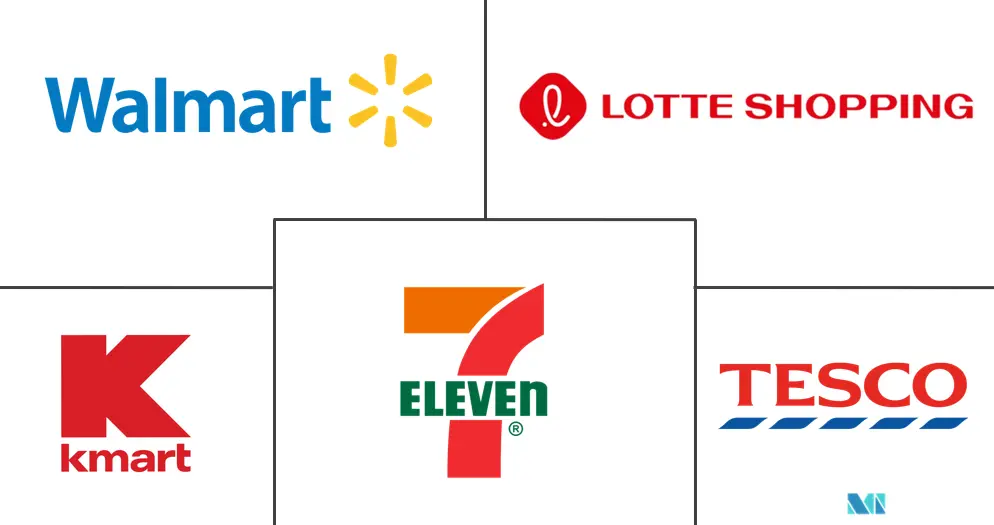Market Size of Supermarkets Industry

| Study Period | 2020 - 2029 |
| Market Size (2024) | USD 0.98 Trillion |
| Market Size (2029) | USD 1.16 Trillion |
| CAGR (2024 - 2029) | 3.30 % |
| Fastest Growing Market | Asia-Pacific |
| Largest Market | Europe |
| Market Concentration | Medium |
Major Players
*Disclaimer: Major Players sorted in no particular order |
Supermarkets Market Analysis
The Supermarkets Market size is estimated at USD 0.98 trillion in 2024, and is expected to reach USD 1.16 trillion by 2029, growing at a CAGR of 3.30% during the forecast period (2024-2029).
A supermarket is a self-service store with many different kinds of food, drinks, and household items set up in other sections. A larger supermarket store has a more comprehensive selection than a grocery store. Globally, supermarkets are expanding by incorporating business intelligence into their systems. With a variety of customers in the market and a time-pressed customer, supermarkets are offering door-to-door delivery within a specific range, providing more utility to the customer. With continuously changing consumer expectations, supermarkets keep pace and find a competitive advantage over other stores. According to National Retail Federation, in 2021, Kroger Co. operated 2,874 stores in the United States. Its store formats include supermarkets, hypermarkets, department stores, convenience stores, and mall jewelry stores.
During COVID-19, consumers switched to shopping online. As a result, retailers tried to meet consumer demand by changing their business model and improving the digital experience within their businesses. People changed their behavior by moving away from frequent shoppers in small baskets to much bigger baskets more infrequently from one store, indicating a change in the time efficiency of buyers. With investment in actual online delivery capability, supermarkets looked out for vulnerable people, assigning their last mile capacity to people who wouldn't be online shoppers. Technology is always helping supermarkets automate their supply chain and make it easier for customers to place orders. This helps them make their business easier to run and lets them focus more on their customers. Supermarkets try to change how people think about them by focusing on price, deals, rewards, speed, convenience, and quality.
Supermarkets Industry Segmentation
A supermarket is a self-service shop offering various food, beverage, and household products organized into sections. The supermarket market is segmented by ownership, application, and geography. Based on the ownership, the market is segmented into the retail chain and independent retailer. Based on the application, the market is segmented into consumer electronics, furniture, food and beverage, toys and stationery, personal care, cosmetics, home textiles, dresses, and others. Based on geography, the market is segmented into North America, Europe, South America, Asia-Pacific, and the Middle East and Africa. The report offers market size and forecasts for the global supermarket market in volume and value (USD) for all the above segments.
| Ownership | |
| Retail Chain | |
| Independent Retailer |
| Application | |
| Consumer Electronics | |
| Furniture | |
| Food and Beverage | |
| Toy and Stationary | |
| Personal Care | |
| Cosmetic | |
| Home Textile | |
| Dresses | |
| Other Applications |
| Geography | ||||||||
| ||||||||
| ||||||||
| ||||||||
| ||||||||
|
Supermarkets Market Size Summary
The supermarket industry is experiencing a transformative phase, driven by technological advancements and changing consumer behaviors. Supermarkets, characterized by their self-service model and extensive product range, are increasingly integrating business intelligence and digital solutions to enhance customer experience and operational efficiency. The shift towards online shopping, accelerated by the COVID-19 pandemic, has prompted supermarkets to adopt new business models, focusing on door-to-door delivery and automated supply chain management. This evolution is aimed at meeting the diverse and time-sensitive needs of consumers, who are now more inclined towards larger, less frequent purchases. Supermarkets are also leveraging technology to improve their service offerings, emphasizing price competitiveness, convenience, and quality to gain a competitive edge in the market.
In North America, supermarkets play a pivotal role in the retail sector, employing strategies like loyalty programs and online promotions to attract and retain customers. The market is highly competitive, with major players such as Walmart, Tesco, and 7-ELEVEN leading the charge. These companies are investing in technology and innovation, such as self-checkout systems and personalized offers, to enhance customer engagement. The market is also witnessing strategic expansions and acquisitions, as seen with GMG's acquisition of Aswaaq and 7-Eleven's purchase of Speedway, which aim to strengthen their market presence. Despite challenges like supply chain disruptions and inflation, supermarkets are focusing on customer loyalty and digital transformation to navigate the evolving market landscape effectively.
Supermarkets Market Size - Table of Contents
-
1. MARKET DYNAMICS
-
1.1 Market Drivers
-
1.2 Market Restraints
-
1.3 Porter's Five Forces Analysis
-
1.3.1 Bargaining Power of Buyers
-
1.3.2 Bargaining Power of Suppliers
-
1.3.3 Threat of New Entrants
-
1.3.4 Threat of Substitutes
-
1.3.5 Intensity of Competitive Rivalry
-
-
-
2. MARKET SEGMENTATION
-
2.1 Ownership
-
2.1.1 Retail Chain
-
2.1.2 Independent Retailer
-
-
2.2 Application
-
2.2.1 Consumer Electronics
-
2.2.2 Furniture
-
2.2.3 Food and Beverage
-
2.2.4 Toy and Stationary
-
2.2.5 Personal Care
-
2.2.6 Cosmetic
-
2.2.7 Home Textile
-
2.2.8 Dresses
-
2.2.9 Other Applications
-
-
2.3 Geography
-
2.3.1 North America
-
2.3.1.1 United States
-
2.3.1.2 Canada
-
2.3.1.3 Mexico
-
2.3.1.4 Rest of North America
-
-
2.3.2 Europe
-
2.3.2.1 Germany
-
2.3.2.2 United Kingdom
-
2.3.2.3 France
-
2.3.2.4 Russia
-
2.3.2.5 Italy
-
2.3.2.6 Rest of Europe
-
-
2.3.3 Asia-Pacific
-
2.3.3.1 India
-
2.3.3.2 China
-
2.3.3.3 Japan
-
2.3.3.4 Australia
-
2.3.3.5 Rest of Asia-Pacific
-
-
2.3.4 South America
-
2.3.4.1 Brazil
-
2.3.4.2 Argentina
-
2.3.4.3 Rest of South America
-
-
2.3.5 Middle-East and Africa
-
2.3.5.1 United Arab Emirates
-
2.3.5.2 South Africa
-
2.3.5.3 Rest of Middle East and Africa
-
-
-
Supermarkets Market Size FAQs
How big is the Supermarkets Market?
The Supermarkets Market size is expected to reach USD 0.98 trillion in 2024 and grow at a CAGR of 3.30% to reach USD 1.16 trillion by 2029.
What is the current Supermarkets Market size?
In 2024, the Supermarkets Market size is expected to reach USD 0.98 trillion.

